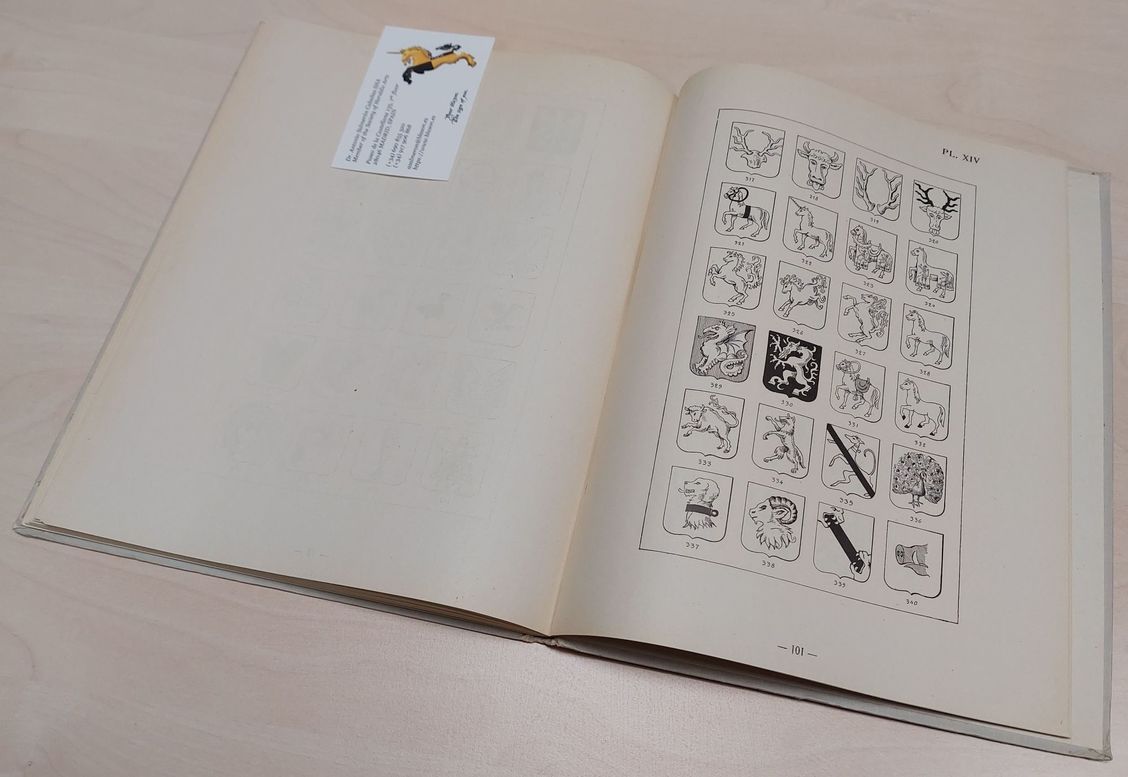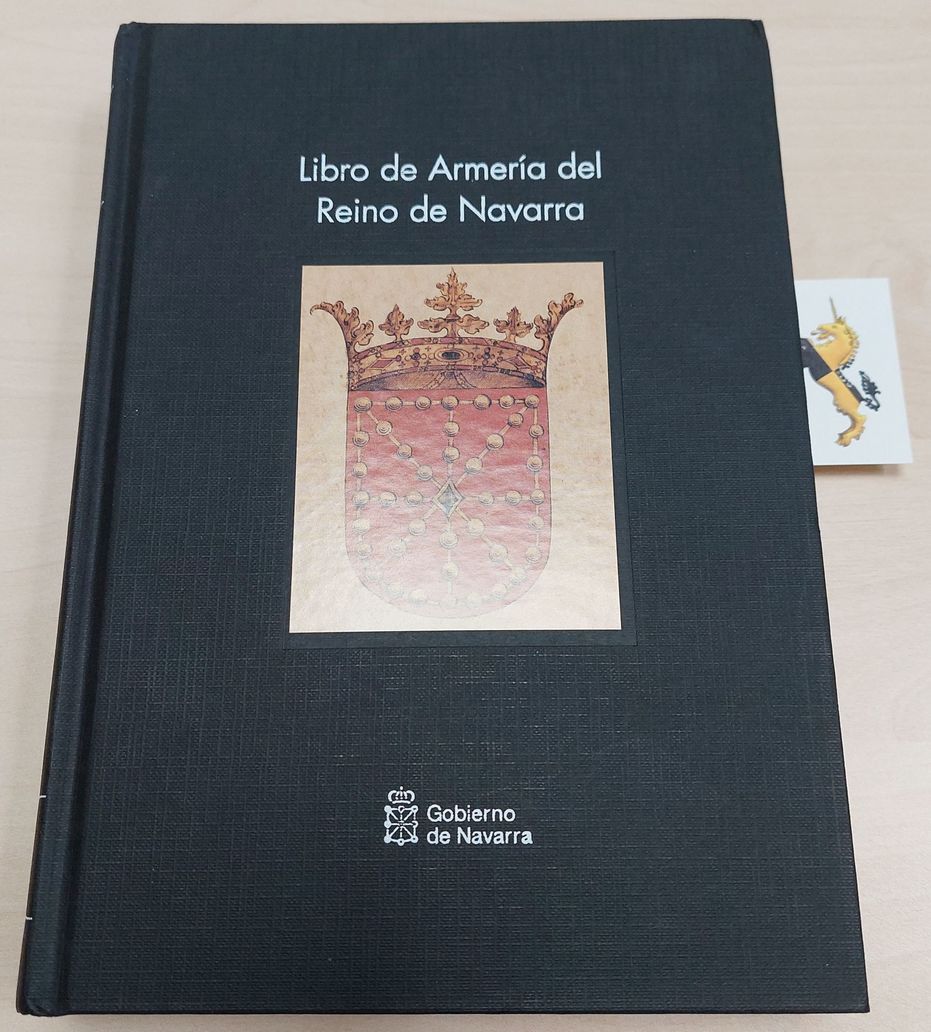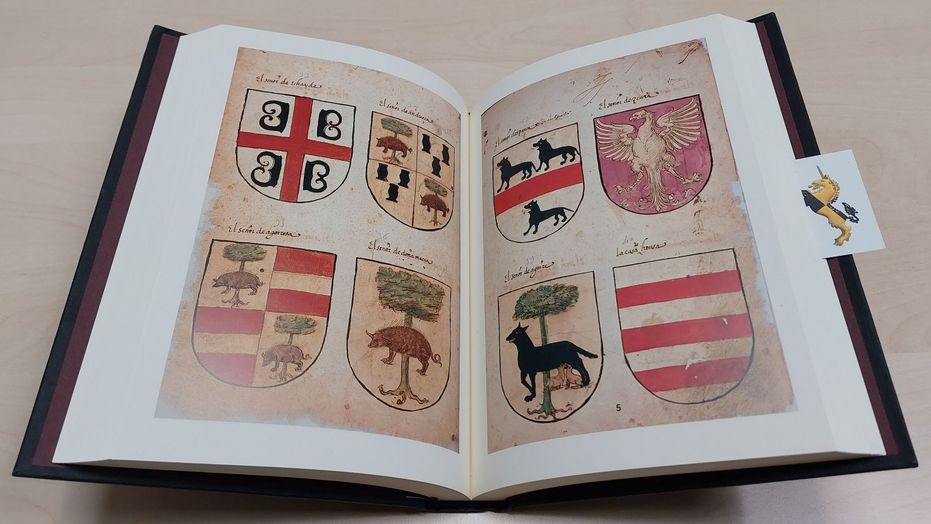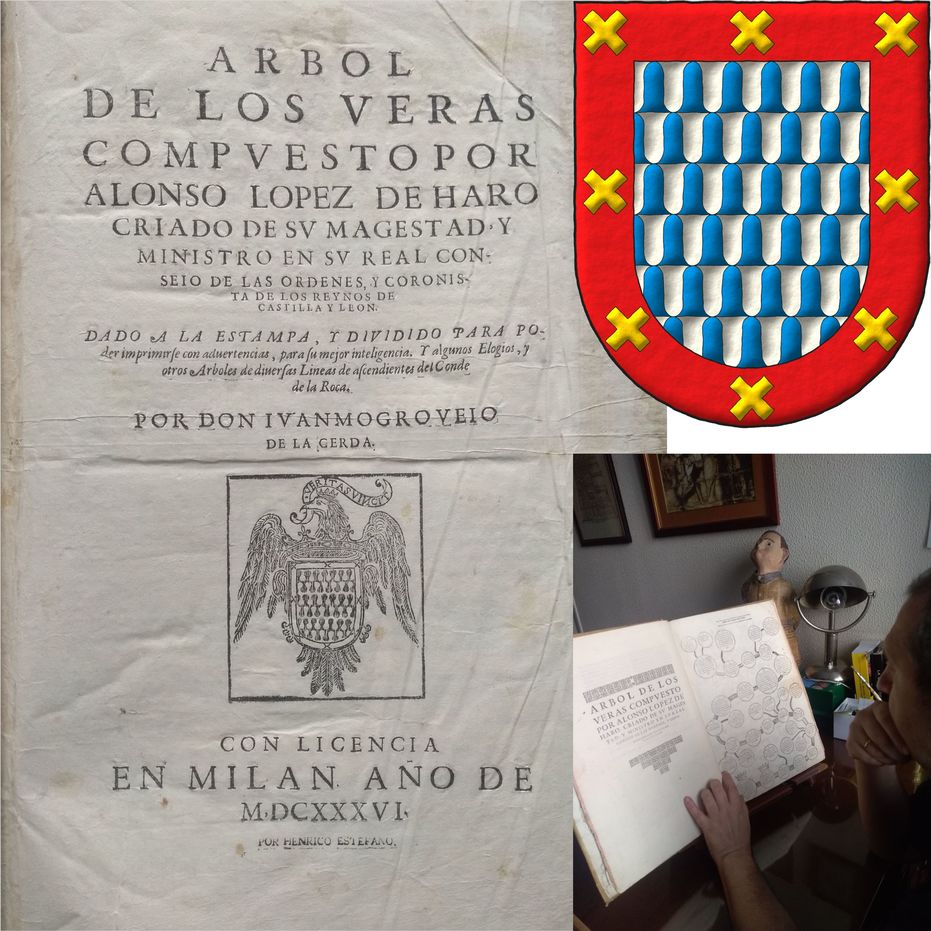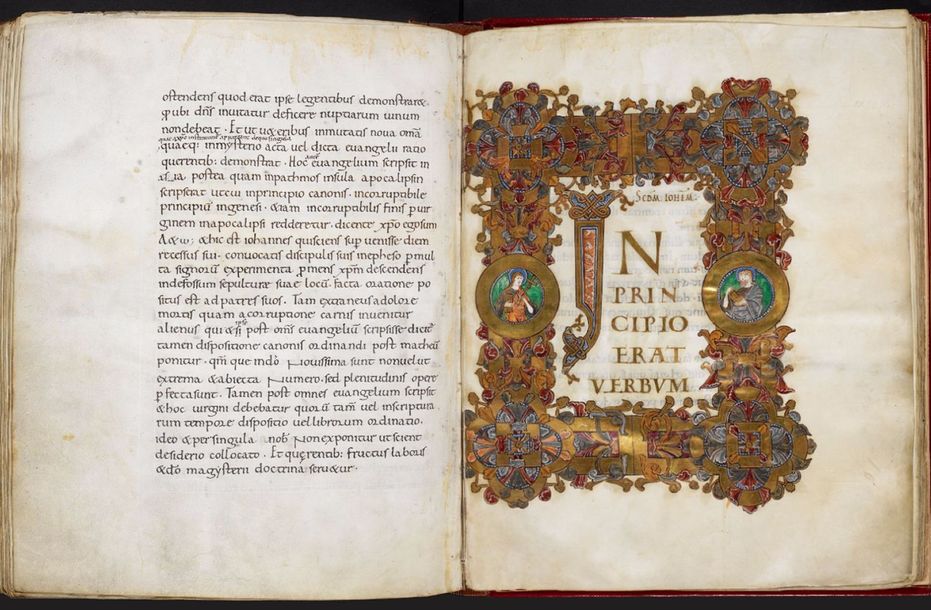
![Ver [Académie internationale d'héraldique; 1952] en referencias bibliográficas. Libro abierto, hojas de plata, filo de oro, guardas de gules, tapas de sable.](../css/Libro.Bibliografia.png)
Académie internationale d'héraldique; 1952
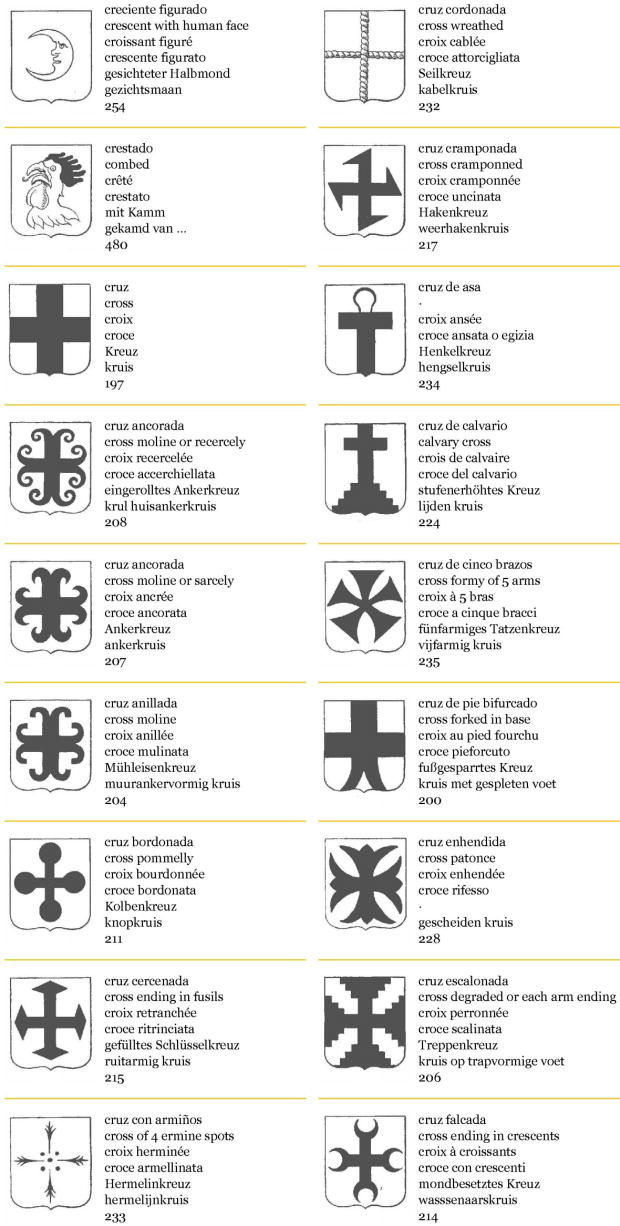
Académie internationale d'héraldique, AIH, «Vocabulaire-Atlas Héraldique en six Langues: Francais - English - Deutsch - Español - Italiano - Nederlandsch», by Gaston Stalins, Le Baron Stalins, with the collaboration of René Le Juge De Segrais, Ottfried Neubecker, Martin de Riquer y Morera, Giacomo Carlo Bascapé, and Mario Gorino-Causa, 119 pages, 530 black and white heraldic pictures, Société du Grand Armorial de France, 179 Boulevard Haussmann, París, 1952.
This book begins with the following sentence: «Heraldique - science et art - qui prit naissance en France vers la moitié du XIIe siècle, s'est propagée très rapidement dans les principaux pays européens».
The number of terms and words of the heraldry by languages is as follows:
- French language: 523 heraldic terms.
- Dutch language: 521 heraldic terms.
- German language: 519 heraldic terms.
- Spanish language: 511 heraldic terms.
- Italian language: 506 heraldic terms.
- English language: 502 heraldic terms.
The names of the authors and collaborators have been checked with [Académie internationale d'héraldique; 1999].
Its 530 heraldic illustrations correspond, according to my calculations to 509 drawings, numbered from 1 to 530. Some images contain several numbers, for example, the image that shows a coat of arms with its mantling, number 528, and its supporters, number 529, a griffin and a lion rampant, it is the same illustation, but with 2 numbers.
Bibliographical reference of century XXI.
Classification: Dictionary, French language, English language, German language, Castilian language, Italian language and Dutch language.
Authors:
- Stalins, Gaston.
- Le Juge De Segrais, René.
- Neubecker, Ottfried.
- Riquer y Morera, Martin de.
- Bascapé, Giacomo Carlo.
- Gorino-Causa, Mario.
Here are the articles quoting this reference:
- Ermine
- Ixai Lanzagorta Ochoa, plain tincture
- Pile issuant from the base in the Dictionary of the Spanish Language
- Sanz Lacorte, J.; 2007
- Sir Thomas Grenville II
- Val'Quirico, wreath an owl
External link:
Internal resources: Aih1952.00.Vocabulaire.Original.pdf, Aih1952.01.Vocabulaire.Sefidn.pdf and Paper edition with a Swedish bookplate.


![Ver [Martinena Ruiz, J. J.; Menéndez Pidal de Navascués, F.; 2001] en referencias bibliográficas. Libro abierto, hojas de plata, filo de oro, guardas de gules, tapas de sable.](../css/Libro.Bibliografia.png)
Martinena Ruiz, J. J.; Menéndez Pidal de Navascués, F.; 2001
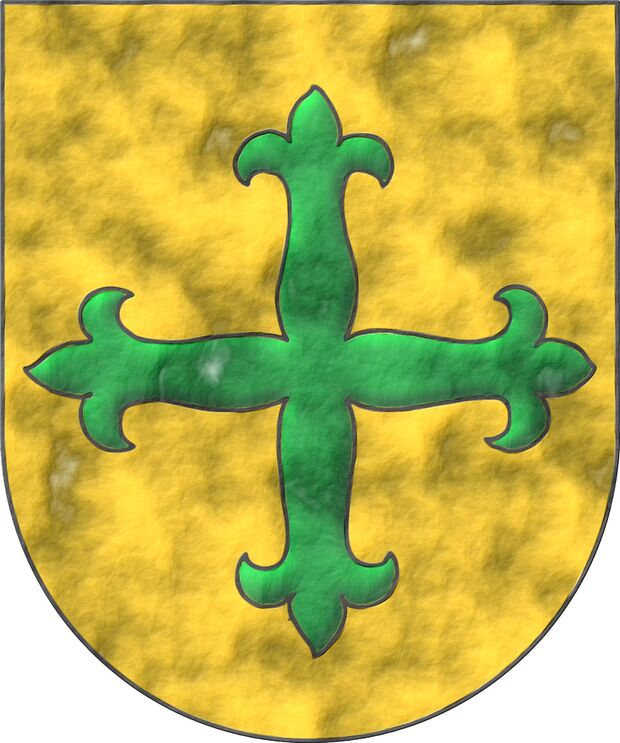
Juan José Martinena Ruiz and Faustino Menéndez Pidal de Navascués, «Book of Armory of the Kingdom of Navarra», Published by the Institución Príncipe de Viana, Directorate-General for Culture, Government of Navarra, 484 pages, ISBN-13 978-84-235-2166-1, ISBN-10 84-235-2166-4, Pamplona, 2001.
Reproduction and transcription of the manuscript armorial [Bosque, J. del; 1540], that is, the copy of the «Book of Armory of the Kingdom of Navarra», preserved in the General Archive of Navarra.
The coat of arms accompanying this bibliographic reference is that of Rada de Navarra following Juan del Bosque.
Both authors had already written and published, separately, about the armorial [Bosque, J. del; 1540], an example of the first is [Martinena Ruiz, J. J.; 1982] and an example of the second is [Menéndez Pidal de Navascués, F.; 1974].
Bibliographical reference of century XXI.
Classification: De bibliotheca.
The 2 authors are Martinena Ruiz, Juan José and Menéndez Pidal de Navascués, Faustino.
Here are the articles quoting this reference:
External resources:


![Ver [Febrer, J.; Century XIII] en referencias bibliográficas. Libro abierto, hojas de plata, filo de oro, guardas de gules, tapas de sable.](../css/Libro.Bibliografia.png)
Febrer, J.; Century XIII
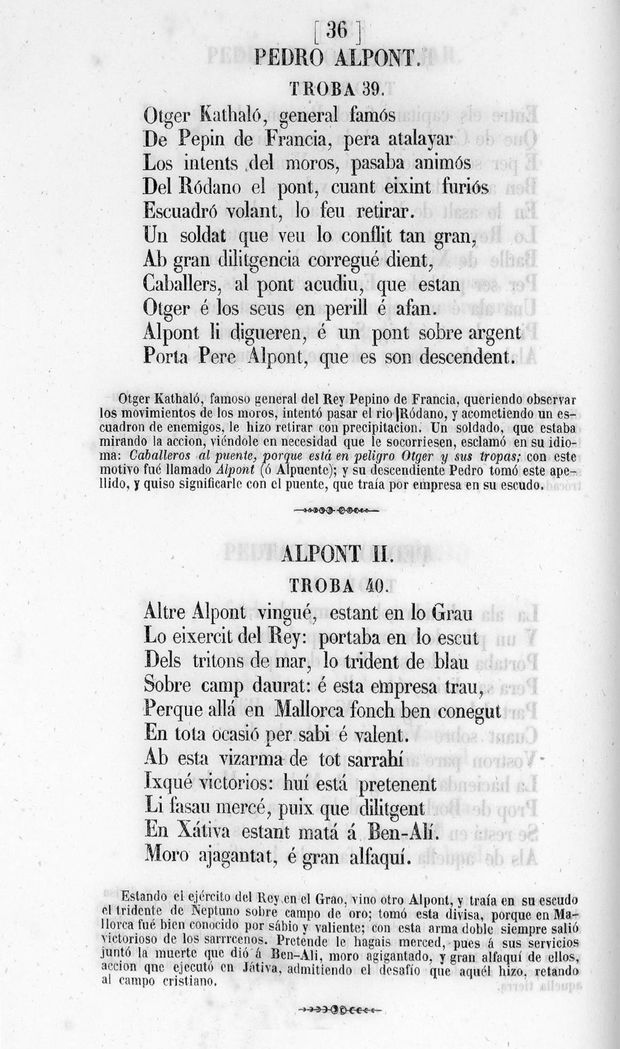
Jaime Febrer, «Trovas de Mossen Jaime Febrer: que tratan de los conquistadores de Valencia», edited by Joaquín María Bover, new edition made with reference to the first and an old manuscript, with notes, illustrated with portrait plates and heraldic plates, 312 pages, printed by Pedro José Gelabert, Palma, 1848.
Historical context and content
Jaime Febrer lived during the reigns of Jaime I El Conquistador, 1207-1276, and his son Pedro III El Grande of Aragon and I of Valencia, 1239-1285. Febrer is believed to have authored a manuscript detailing 278 knights who participated in the conquest of Valencia alongside Jaime I, forming the foundation of many noble lineages in the city and kingdom of Valencia.
The manuscript, dedicated to Pedro III and I of Valencia, is composed in short verses known as «trovas» ~ «trobas», written in the «Lemosín» language, an old form of Valencian. Each trova includes a description of the knights' coats of arms.
A re-edition of this manuscript was published by Joaquín María Bover in 1848 in Palma de Mallorca.
Illustrative example of trova 39, Alpont
The «trova 39» is dedicated to Pedro Alpont, whose ancestor helped the General Otger Kathaló and adopted the surname Alpont following an event involving a bridge. This poem «trova 39» serves as an illustrative example, describing the blazon of Pedro Alpont. The blazon described in this trova is simple: «Argent, a Bridge».
The story included in this trova tells how Otger Gotlant, also known as Oger Catalón or Catazlon, a general under King Pepin of France, was near the Rhône observing the Moors. He crossed the river by one of its bridges to better track the enemy’s movements. Suddenly, he was attacked by a squadron of Saracens, forcing him to retreat hastily. A soldier on the other side of the river saw this and began shouting in the Lemosín language, calling for reinforcements: «Al pont, caballers, al pont» ~ «To the bridge, knights, to the bridge», as Otger and his men were in danger. According to this «trova 39» by Jaime Febrer, from that moment on, this soldier was known by the surname Alpont. One of his descendants, named Pedro Alpont, participated in the conquest of Mallorca and later moved to Valencia, following King Jaime I El Conquistador, leaving behind the Alpont surname for his successors.
Another Alpont, referred to as Alpont II, appears in trova number 40, where his blazon is characterized by a trident.
Bibliographical reference of century XIII.
Classification: Valencian language and In black and white.
The author is Febrer, Jaime.
External link:
Internal resources: FebrerJXIII.Trobas.BoverJM1848.Parcial.155.Paginas.pdf Partial PDF with the first 155 pages.


![Ver [Burke, J.; 1836] en referencias bibliográficas. Libro abierto, hojas de plata, filo de oro, guardas de gules, tapas de sable.](../css/Libro.Bibliografia.png)
Burke, J.; 1836
John Burke, «A Genealogical and Heraldic History of the Commoners of Great Britain and Ireland: Enjoying Territorial Possessions or High Official Rank; but Uninvested with Heritable Honours», 4 volumes, volume 1 with 726 printed pages, volume 2 with 740 printed pages, volume 3 with 738 printed pages, volume 4 with 805 printed pages, published for Henry Colburn by R. Bentley, Bell and Bradfute, in Edinburgh, and J. Gumming in Dublin, London, 1836.
Overview
This extensive work spans four volumes, 726 + 740 + 738 + 805 = 2309 pages, and provides a detailed account of the genealogy and heraldry of commoners in Great Britain and Ireland who held territorial possessions or high official ranks, yet were not vested with heritable honors.
Coats of arms and blazons
Each volume contains black and white illustrations of coats of arms, typically including the crest and wreath, with some also featuring supporters. The illustrations do not utilize hatching or tricking for tinctures, the tinctures must be seen in the text of the written blazons. For each lineage, the coat of arms is illustrated at the beginning, followed by a genealogical account, and the blazon is provided at the end. For example, for the Talbot lineage, in the volume 3, page 359-360, the blazon is written as follows: «Arms - Gu. a lion rampant, within a bordure engr. or. Crest - On a chapeau gu. turned up ermine, a lion statant or, the tail extended. Motto - Prest d'accomplir.» where «gu» is Gules and «or» is Or.
Bibliographical reference of century XIX.
Classification: Armorial roll, English language and In black and white.
Author: Burke, John.
The following article cites this bibliographic reference:
External resources:
Internal resources: BurkeJ1836.Commoners.Volume.01.pdf 758 pages in PDF format, BurkeJ1836.Commoners.Volume.02.pdf 772 pages in PDF format, BurkeJ1836.Commoners.Volume.03.pdf 762 pages in PDF format and BurkeJ1836.Commoners.Volume.04.pdf 838 pages in PDF format.


![Ver [Mogrovejo de la Cerda, J.; 1636] en referencias bibliográficas. Libro abierto, hojas de plata, filo de oro, guardas de gules, tapas de sable.](../css/Libro.Bibliografia.png)
Mogrovejo de la Cerda, J.; 1636
Juan Mogrovejo de la Cerda, «Árbol de los Veras compuesto por Alonso López de Haro, Criado de Su Majestad y Ministro de su Real Consejo de las Órdenes y Cronista de los Reinos de Castilla y León», bound in original parchment, Milan, 1636.
Contents
The book contains a total of 66 main genealogical trees, each with an average of 28 nodes/persons, totaling over 1700 nodes. Additionally, it includes 41 lines of descent with approximately 1150 individuals. The content is composed of:
- Title page with the coat of arms of the Veras.
- Errata and additions.
- Dedication.
- Warnings and introduction by Juan Mogrovejo de la Cerda, folios 1 to 4.
- Tree of the Veras, folios 6 to 66, with 61 genealogical trees.
- Eulogies of five Christian princes known for their virtue and valor, with trees of their descendants up to the Count of La Roca, folios 67 to 72.
- Linear trees of descent from Don Fernando Carlos Antonio de Vera, Doña María Antonia de Vera y Tovar, and Doña Catalina de Vera, folios 73 to 114, with 41 trees.
- Limitations of the work on folio 115.
- Indexes with handwritten corrections, folios 116 to 122.
- Additions to the edition, including a genealogical tree of Don Luis Francisco de la Cerda Sandobal y Rojas, Marqués de Alcalá.
- Additional handwritten documents attached but not bound.
In the previous image, The canting arms of Juan Antonio de Vera y Zúñiga, Count of La Roca, in this book about his genealogy, are canting because «vair~veros~Vera».
The motto in the beak of his sable eagle is «Veritas Vincit», although some authors claim that not all his trees honor this motto [Vera-Ortiz, J.A.; 2009].
The colored version of the coat of arms in this image was painted by me. Blazon: Vair ancient, a bordure gules charged with eight saltires couped Or.
Bibliographical reference of century XVII.
Classification: De bibliotheca, In black and white and Castilian language.
Author: Mogrovejo de la Cerda, Juan.
Bibliographic reference mentioned in the following articles:
External resource:
Internal resources: Physical book..


![Ver [Cnut Gospels; 1020] en referencias bibliográficas. Libro abierto, hojas de plata, filo de oro, guardas de gules, tapas de sable.](../css/Libro.Bibliografia.png)
Cnut Gospels; 1020
Anonymous, «The Cnut Gospels», call number Royal MS 1 D IX, illuminated manuscript, Canterbury, circa 1020.
Contents and history
This manuscript, containing the Four Gospels, dates from the early 11th century. It is believed to have belonged to Christ Church, Canterbury, and may have been created there. It is named after Cnut, King of England, who reigned from 1016 to 1035, due to an added text in Old English that names Cnut and his brother Harold as brothers of the monastery.
Despite its royal associations, the manuscript only entered the Old Royal Library in the early 17th century, when Henry Frederick, Prince of Wales, acquired the library of John, 1st Baron Lumley.
Decoration and inscription details
The manuscript features full-page decorations at the beginning of each Gospel, with initials illuminated in gold, and lush stylized leaves in the borders, characteristic of late Anglo-Saxon decoration. For example, the border of the Gospel of Mark includes stylized leaves and embedded roundels of saints, and the incipit page for the Gospel of John is particularly notable for its decorated frame and gold initials.
Bibliographical reference of century XI.
Classification: Manuscript, English language and In color.
The author is unknown.
Bibliographical reference mentioned in the following article:


![Ver [Mayer, L. A.; 1933] en referencias bibliográficas. Libro abierto, hojas de plata, filo de oro, guardas de gules, tapas de sable.](../css/Libro.Bibliografia.png)
Mayer, L. A.; 1933
Leo Aryeh Mayer, «Saracenic Heraldry: A Survey», published by the University of Oxford at the Clarendon Press, Oxford, 1933.
The work provides a fully documented armorial roll of Saracenic sultans, princes, and knights, designed to meet the frequently expressed wish of students of Muslim archaeology. It is a fundamental reference work and remains as one of the most authoritative works on this subject.


![Ver [Stodart, R. R.; 1881] en referencias bibliográficas. Libro abierto, hojas de plata, filo de oro, guardas de gules, tapas de sable.](../css/Libro.Bibliografia.png)
Stodart, R. R.; 1881
Robert Riddle Stodart, «Scottish Arms: Being a Collection of Armorial Bearings, A.D. 1370-1678», Reproduced in facsimile from contemporary manuscripts with heraldic and genealogical notes, edited by William Paterson, Edinburgh, 1881.
This work is a comprehensive two-volume set that reproduces armorial bearings from various manuscripts dating from 1370 to 1678. The collection includes detailed heraldic and genealogical notes that accompany the facsimiles. It is an essential reference for anyone studying Scottish heraldry and genealogy.
Volume 1
Volume 1 contains an introduction, an alphabetical index of coats of arms, and 125 color plates, each displaying between 1 and 9 coats of arms per plate. This volume 1 is dedicated to the color illustrations of the coats of arms, while volume 2 consists entirely of text without illustrations. In volume 1, the Plates section with color illustrations of coats of arms follows the same structure as volume 2, as will be seen in the section dedicated to volume 2. The contents of volume 1 are as follows.
- Introduction.
- Index to the plates.
- List of names in the order in which they occur on the plates.
-
Plates:
- Armorial de Gelre, pages A to E.
- Armorial de Berry, pages I to II.
- Forman's Roll, pages 12 to 21.
- Sunderland Hall Ms., pages 22 to 24.
- Additions to Sir David Lindsay's Ms., pages 24^ to 34.
- Workman's Ms, pages 35 to 84.
- Kings' and Nobility's arms, pages 85 and 86.
- Sir David Lindsay the Youngers Ms, pages 87 to 94.
- Sir James Balfour's Ms, pages 95 and 96.
- Lyon register, pages 97 and 98.
- Earl of Crawford's Ms., pages 99 and 100.
- Gentlemen's arms, pages 101 to 106.
- Funeral escutcheons, pages 106 to 110.
- Sundries, pages 111 to 118.
- Heraldic and genealogical notes.
- Index to the notes.
- Additions and corrections.
Volume 2
Volume 2 continues the collection and includes further armorial bearings and notes and also references several historical armorials, with the following contents:
- I. The armorial de Gelre, circa 1369.
- II. The armorial de Gilles le Bouvier, Berry Roi d'Armes, circa 1450-55.
- III. Roll of arms, by sir Robert Forman, Lyon King of Arms, circa 1562.
- IV. Sunderland Hall manuscript.
- V. Additions to the booke and register of armes, compiled by sir David Lindsay, Lyon King of Arms.
- VI. Illuminated heraldic manuscript, called "Workman's," circa 1565-6.
- VII. Kings' and nobility's arms, circa 1566.
- VIII. Illuminated manuscript, circa 1603-5, ascribed to sir David Lindsay, Lyon King of Arms.
- IX. Armorial manuscripts by sir James Balfour, Baronet, Lyon King at Arms 1630-54, and another herald.
- X. The public register of all arms and bearings in Scotland, A.D. 1672-78.
- XI. Heraldic manuscript compiled during the reign of James VI, the property of the Earl of Crawford and Balcarres.
- XII. Gentlemen's arms collected during the reign of Charles I.
- XIII. Funeral escutcheons.
- XIV. Sundries.
Bibliographical reference of century XIX.
Classification: Armorial roll, English language and Black and white with color plates.
The author is Stodart, Robert Riddle.
External resources:
Internal resources: StodartR1881.ScottishArms.Heavy.Volume.01.pdf Heavy PDF, StodartR1881.ScottishArms.Heavy.Volume.02.pdf Heavy PDF, StodartR1881.ScottishArms.Light.Volume.01.pdf Light PDF and StodartR1881.ScottishArms.Light.Volume.02.pdf Light PDF.

Continue with: Google Plus.
-
Language
-
Categories of heraldry
-
Divisions of the field
- Without divisions
- Party per pale
- Party per fess
- Party per bend
- Party per bend sinister
- Tierce
- Tierce sinister
- Tierced per pale
- Tierced per fess
- Tierced per bend
- Tierced pallwise inverted
- Quarterly
- Quarterly per saltire
- Gyronny
- Party per fess, the chief per pale
- Party per pale, the sinister per fess
- Party per fess, the base per pale
- Party per pale, the dexter per fess
- Chapé
- Chaussé
- Embrassé
- Contre-embrassé
- Party per chevron
- Enté
- Enté en point
- Flanched
-
Metals
-
Colours
-
Furs
-
Other tinctures
-
Ordinaries and sub-ordinaries
-
Diminutives of the ordinaries
-
Geometric charges
-
Composite ordinaries
-
Inanimate charges from Nature
Atom, Crescent, Diamond, Emerald, Estoile, Increscent, Lightning flash, Moon, Mount, Mullet, Mullet of four points, Orbital, Plough of Ursa Major, Rainbow, Ray of the sun, River, Sea, Snowflake, Sun, Sun in splendour, Sun of May, Trimount, Water and Wave.
-
Vegetal charges from Nature
Acorn, Apple, Apple tree, Ash, Bluebonnet, Camellia, Chrysanthemum, Cinquefoil, Cornflower, Dogwood flower, Double rose, Elm, Fleur de lis, Flower, Gourd, Holm oak, Hop cone, Kapok tree, Laurel, Lily, Linden, Lotus flower, Madonna lily, Mexican cedar tree, Oak, Olive tree, Palm tree, Plantain plant, Pomegranate, Poplar leaf, Rose, Shamrock, Sunflower, Thistle, Tree, Tulip, Vine and Wheat.
-
Animal charges from Nature
Badger, Bald eagle, Barbel, Barn owl, Bear, Beaver, Beetle, Bighorn sheep, Blackbird, Boar, Brach hound, Bull, Doe, Dog, Dolphin, Dove, Eagle, Elephant, Falcon, Female figure, Fish, Flame, Fly, Fox, Frog, Goat, Goldfinch, Goose, Heron, Horse, Hummingbird, Jaguar, Lark, Leopard, Lion, Lion passant, Lion rampant guardant, Lioness, Lynx, Male figure, Martlet, Merino ram, Owl, Panther, Parrot, Peacock, Pelican, Pelican in her piety, Puffin, Quetzal, Raven, Roe deer, Rooster, Savage, Seagull, Serpent, She-wolf, Stag, Starling, Talbot, Tyger, Vulture, Warren hound and Wolf.
-
Parts of natural charges
Arm, Beak, Branch, Caboshed, Chest, Claw, Covert, Dorsal fin, Eagle claw, Ermine spot, Escallop, Feather, Foot (palmiped), Foreleg, Forepaw, Hand, Head, Heart, Hoof, Leaf, Neck, Ostrich feather, Palm frond, Paw, Roe deers' attires, Shoulder, Sprig, Stags' attires, Stem, Swallow-tail, Tail, Tail addorsed, Tail fin, Talon, Tooth, Trunk, Trunk (elephant), Two hands clasped, Two wings in vol, Udder, Wheat spike, Wing and Wrist.
-
Artificial charges
Ace of spades, Anchor, Anvil, Arch, Arm vambraced, Armillary sphere, Arrow, Axe, Bell, Bell tower, Beret, Bonfire, Book, Bookmark, Bow, Branding iron, Bridge, Broken, Buckle, Cannon, Cannon dismounted, Cannon port, Canopy roof, Carbuncle, Castle, Celtic Trinity knot, Chain, Chess rooks, Church, Clarion, Clay pot, Closed book, Club, Column, Comb, Compass rose, Conductor's baton, Cord, Covered cup, Crozier, Crucible, Cuffed, Cup, Cyclamor, Dagger, Double vajra, Drum, Ecclesiastical cap, Fanon, Federschwert, Fleam, Four crescents joined millsailwise, Galician granary, Garb, Gauntlet, Geometric solid, Grenade, Halberd, Hammer, Harp, Host, Hourglass, Key, Key ward, Knight, Knot, Lantern, Letter, Line, Loincloth, Menorah, Millrind, Millstone, Millwheel, Monstrance, Mortar, Mullet of six points pierced, Nail, Non-classic artifact, Norman ship, Number, Oar, Oil lamp, Open book, Page, Pair of scales, Parchment, Pestle, Piano, Pilgrim's staff, Plough share, Polish winged hussar, Port, Portcullis, Potent, Quill, Ribbon, Rosette of acanthus leaves, Sabre, Sackbut, Sail, Scroll, Scythe, Sheaf of tobacco, Ship, Skirt, Spear, Spear's head, Stairway, Star of David, Step, Sword, Symbol, Tetrahedron, Torch, Tower, Trident, Trumpet, Turret, Two-handed sword, Wagon-wheel, Water-bouget, Wheel, Winnowing fan and With a turret.
-
Immaterial charges
Angel, Archangel, Basilisk, Dragon, Dragon's head, Garuda, Golden fleece, Griffin, Heart enflamed, Justice, Mermaid, Our Lady of Mercy, Ouroboros, Paschal lamb, Pegasus, Phoenix, Sacred Heart of Jesus, Saint George, Sea-griffin, Trinity, Triton, Unicorn, Winged hand and Wyvern.
-
External elements
-
Heraldic creations
-
References
-
Formats
-
Keywords on this page
Port and windows, Armorial roll, Azure, Bibliography, Bordure, Charged, Party per fess, De bibliotheca, Dictionary, In black and white, Black and white with color plates, In color, Photographic, Genealogy, Google Plus, Gules, German language, Castilian language, French language, English language, Italian language, Dutch language, Valencian language, Arab language, Manuscript, Eight, Ordered, Or, Poplar leaf, Argent, Without divisions, Social networks, Kingdom of Navarre, Century XI, Century XIII, Century XIX, Century XVII, Century XX, Century XXI, Saltire, Technology, Tower, One and Vair ancient.

